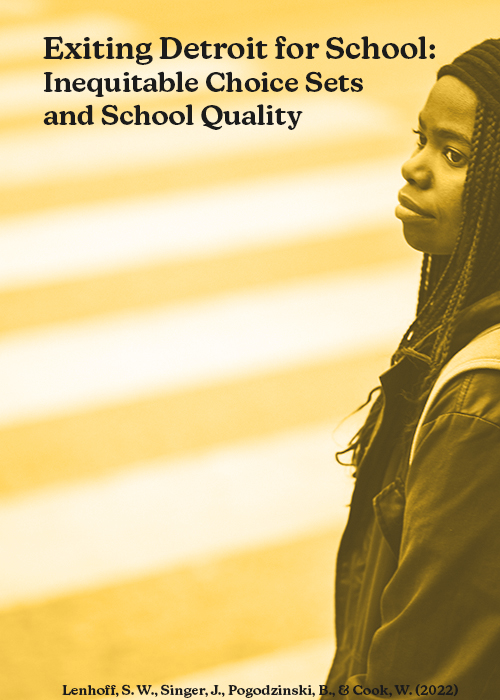Research
Check out our academic publications, policy reports, and working papers. Browse all of our work, or search by topic or type.
Page 3 of 3
Exiting Detroit for School: Inequitable Choice Sets and School Quality
Research has documented the complexity of parent-decision making within school choice marketplaces, including the ways in which individual preferences, social networks, and geography influence where parents choose to enroll their children in school. Yet, parent choices are constrained by the ways in which these dynamics intersect with existing school characteristics and locations. By constructing unique choice set “landscapes” for 194 Detroit neighborhoods, taking into account where current neighbors attend school in the city, this paper contributes new evidence on the influence of peer enrollment on school choosing, and how peer choice sets differ from students’ nearest schools. We find that parents are responsive to lower quality schools in their choice sets when choosing to exit and that choice set quality varies by race, with Black students having lower quality schools in their Detroit choice sets.

School Characteristics and Student Mobility in Detroit
Within- and between-year mobility was particularly high among Detroit resident students compared to other students in Metro Detroit. Students were less likely to make a within-year move if they attended a school categorized as having a high rating in organizational climate, as measured by the 5Essentials surveys. Rates of school-level chronic absence were associated with both within- and between-year mobility, suggesting that other elements of school organizational climate may influence student movement.

Exiting Detroit for School: Inequitable Choice Sets and School Quality
Students who exited Detroit for school had lower quality schools (test score performance, teacher and student stability, new teachers, discipline) in Detroit than students who stayed. Students who attended a non-Detroit school enrolled in schools that had, on average, higher discipline rates, more new teachers, lower teacher retention, and higher test scores than their choice sets in Detroit. The physical and cultural geography of students’ neighborhood choice sets varied dramatically across the city. Students who lived in neighborhoods where most of their neighbors went to just a few schools were less likely to exit.

Student Exit, Mobility, and Attendance in Detroit
This comprehensive report documents Detroit students' school choices, attendance, and mobility as of 2017-18. Nearly a quarter of Detroit students attended a public school in the suburbs in 2017-18. Most had previously attended school in Detroit. Students were more likely to have attended school outside the city when they had fewer city schools near where they lived, raising important policy questions about school locations, closures, and access. Seventeen percent of Detroit students switched schools between school years when they were not in a transition year. Early elementary school and 9th grade students were most likely to be movers, and more than half of all non-routine moves were among students who did not change residence, suggesting that dissatisfaction, disciplinary pushout, or other school-level issues may be contributing to mobility. More than half of students who attended school in Detroit were chronically absent, missing 10% or more of the school year. Controlling for individual student characteristics, students were more likely to be chronically absent if they attended a school with high rates of student mobility, were new to the school, commuted further to get to school, and when they lived in neighborhoods with higher asthma rates.

School Organizational Effectiveness and Chronic Absenteeism: Implications for Accountability
Chronic absenteeism in K-12schoolsis strongly associated with critical educational outcomes such as student achievement and graduation. Yet, the causes of chronic absenteeism are complex, with environmental, family/individual, and school factors all affecting the likelihood of a student attending school regularly. This exploratory study examines whether school organizational effectiveness has the potential to moderate external influences on chronic absenteeism. Using school-level scores from the 5Essentials surveys, we find that, in traditional public schools, schools that are organized for effectiveness have lower rates of chronic absenteeism, while controlling for student demographics and grade level. In particular, schools with higher scores for “involved families” have lower chronic absenteeism. While charter schools in Detroit have significantly lower rates of chronic absenteeism than traditional public schools, we did not find an association between organizational effectiveness and chronic absenteeism in charter schools. This suggests that student sorting by school type may produce variation in chronic absenteeism rates that is not moderated by school actions. These findings have important implications for practice and policy, as educators seek to reduce chronic absenteeism in response to pressures from high-stakes accountability systems.



